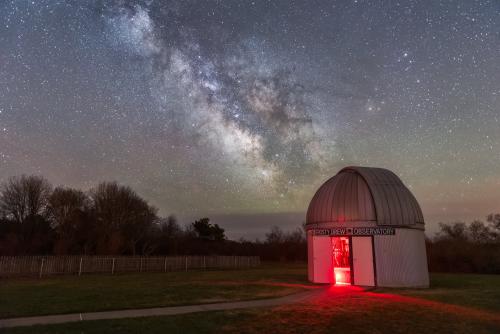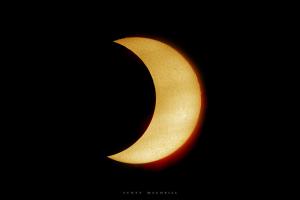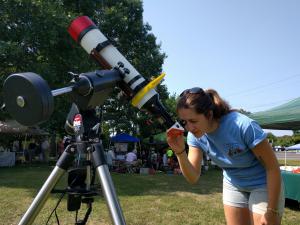Celebration of Space - May 19, 2023

The Milky Way stretches over Frosty Drew Observatory during spring and summer. Image credit: Brian Swope
At 11:56 am ET this morning (Friday, May 19, 2023), the Moon will orbit into a position where it ends up in between the Earth and the Sun. Astronomers call this Conjunction, but everyone else calls it the New Moon. On this day, the Moon rose with the Sun, and will set with the Sun. The side of the Moon that faces us will be in total night, with the opposite side of the Moon in direct sunlight. With two fabulous solar eclipses coming to the United States over the next year’s time, the new moon will certainly become a topic of interest. This is because a solar eclipse can only happen during a new moon.
During a solar eclipse, the Moon will orbit into the light path of the Sun, causing us to catch sight of that stunning eclipse view. A question that I often hear is “why don’t we have a solar eclipse with every new moon?” This is a valid point of view, because the Moon is in between the Earth and the Sun during the new phase. The answer to that question comes down to the inclination of the Moon’s orbit around Earth. The Moon will orbit Earth inclined 5.1° to the ecliptic. The ecliptic is the path the Sun takes across the sky, and represents the plane of the Solar System. Because of this inclination, the Moon can be anywhere from 5.1° above to 5.1° below the ecliptic during the new phase. Which often puts the Moon above or below the direct light path of the Sun. The Moon would have to be within 1.5° either above or below the ecliptic for the prospect of a solar eclipse. Your location on Earth matters as well because the Moon is quite close to Earth (238,000 miles) compared to the Sun (93 million miles). Because of this, lower South America may experience a solar eclipse, but upper North America does not.
Take a moment tonight to step outside and note the sky without the presence of the Moon. Now is also the time to start planning your getaways for the coming solar eclipses. The first eclipse will occur on October 14, 2023, and will be an annular eclipse (ring of Sun around the Moon), which will appear as a 19% partial eclipse for Rhode Island sky watchers. Here is the Frosty Drew event for that Saturday: https://frostydrew.org/Solar-Eclipse. The second eclipse, which is the real rocket sauce event, will happen on April 8, 2024, when a total solar eclipse will happen over the US. In Rhode Island we will see the Sun eclipsed 98% by the Moon, but traveling to upstate New York, or Vermont will get you a stunning view of the total eclipse. Get your eclipse glasses now!
Tonight, Friday, May 19, 2023 will bring the end of the Frosty Drew Stargazing Nights for spring 2023, because next Friday, May 26, 2023, we bring back our fantastic Summer Stargazing Nights events. In 2023 we have some amazing activities planned for our summer events, bringing back some of our old favorites, and adding some new ones.
Returning this year will be our solar observation program, which is set to rock socks in 2023. Solar activity has exploded this year, and as we continue towards solar maximum, it’s just going to get better. Additionally, we have done some upgrades to our Lunt Hydrogen Alpha solar telescope, which will make the views even more mind blowing! The solar observations start at 6:30 pm and go until the Sun drops into the western tree line.
In 2023, the Sky Theatre has been completely re-imagined, and all upgrades to the presentation layers are now completed. This summer will see the introduction of a new series of short features that will run on a schedule posted at the Greeters Station, kiosk, and Sky Theatre entry point. We will also have speakers lined up this summer, including past fan favorites. Another theme of this summer will be preserving the dark sky of Charlestown, Rhode Island, specifically Ninigret Park, which will bring screenings of The City Dark to the Sky Theatre, which will include a short presentation showing practical examples on how you can help stop light pollution.
Story Time Under the Willow will be returning this year with kid friendly stories about the cosmos happening twice per night on the shore of Little Nini Pond, under the large willow tree. The Lunar Lounge will come back to nights that have a Moon present, which is a live projection of the Moon on the northwest exterior wall of the Sky Theatre. The old 16 inch telescope, that used to be in the dome, is being reintroduced on the North Lawn this summer, completely retrofitted with modern equipment. There is so much more lined up for the summer this year, that we cannot list it all here. But the best way to learn about what’s going on is to visit on Friday nights.
Tickets will be required to visit our Summer Stargazing nights, but they are free, and we will be increasing our capacity on site, making it easier for visitors to attend. So gear up and get excited about a fantastic summer of astronomy at Frosty Drew, and set your inner geek loose!
On Saturday, May 27, 2023, the Charlestown RI Dark Sky Advocates will partner with Frosty Drew Observatory and Science Center in hosting a star party in Ninigret Park. A star party is a chance to bring your own gear out to celebrate a night of astronomy. This will give you a chance to let your swanky gear shine on, but also give users a chance to seek help with their equipment from others that are more experienced, and will allow for visitors without equipment to sample some top notch gear. Though the biggest perk of a star party is getting out with or without equipment to experience the amazing beauty of the night. Everything from the stars, to the whip-poor-will birds, toads, coyotes, owls, and so much more. The world at night is just as alive as the world during the day, but totally different. The Moon will be at First Quarter that night, which will bring a bit of moonlight to the night sky, though at that phase, the view of the Moon will be stunning. So put this night on your calendar, and come out to Ninigret Park to celebrate the dark sky, and revel in all the wonders of the night. The party starts at 8:30 pm and goes until 10:30 pm. Read about the event. Then take a moment to join the Charlestown RI Dark Sky Advocates group.
Evening passes of the International Space Station (ISS) continue this week over the US. Even though all-night passes of the ISS are no longer visible, but will return next month, all evening passes will continue to be visible this week. Here are several opportunities to catch sight of the ISS this weekend and coming week:
Fri, May 19 at 8:37 pm, starting in the WNW, rising to 21°, heading towards the NNE
Sat, May 20 at 11:04 pm, starting in the NNW, rising to 20°, and into orbital sunset
Sun, May 21 at 10:15 pm, starting in the NNW, rising to 17°, heading towards the NE
Mon, May 22 at 11:03 pm, starting in the NW, rising to 32°, and into orbital sunset.
Tue, May 23 at 10:14 pm, starting in the NW, rising to 24°, heading towards the ENE, and into orbital sunset
Wed, May 24 at 11:02 pm, starting in the NW, rising to 40°, and into orbital sunset
Thu, May 25 at 10:14 pm, starting in the NW, rising to 47°, heading towards the ENE, and into orbital sunset
There aren’t any really spectacular passes over the next several nights, though passes are visible each night. You may notice “orbital sunset” listed along some of the pass times. This happens when the ISS begins to orbit into Earth’s shadow. The station is reflecting sunlight, which is what allows us to see it passing overhead, once the station enters Earth’s shadow it will quickly fade from our view. During this time, residents of the station are experiencing sunset. The ISS is so bright when it passes, that it will be visible even through thin cloud cover. So put these times on your calendar, and set your alarms to catch a view of a space based residence passing over.
- Author:
- Scott MacNeill
- Entry Date:
- May 19, 2023
- Published Under:
- Scott MacNeill's Columns





